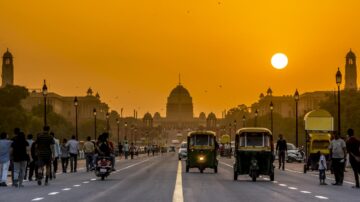by Priya Malhotra
 When I think of New York City, the first image that rises to the surface isn’t its vaunted skyline, those defiant towers scraping at the heavens. It isn’t the classical grandeur of the Metropolitan Museum where civilizations whisper through marble and canvas, nor the razzle-dazzle of Broadway where melodies unfurl amidst a fever of lights and applause. No, of all the things I could remember, the image that lingers most is one of angst—dense, unrelenting and amorphous, like yellowing seepage on the walls of an old house, eating it from the inside out.
When I think of New York City, the first image that rises to the surface isn’t its vaunted skyline, those defiant towers scraping at the heavens. It isn’t the classical grandeur of the Metropolitan Museum where civilizations whisper through marble and canvas, nor the razzle-dazzle of Broadway where melodies unfurl amidst a fever of lights and applause. No, of all the things I could remember, the image that lingers most is one of angst—dense, unrelenting and amorphous, like yellowing seepage on the walls of an old house, eating it from the inside out.
The city I left after 25 years reminds me of the insidious decay in Charlotte Perkins Gilman’s “The Yellow Wallpaper”—that creeping, spreading rash of dread and despair. It’s there in the hunched shoulders of a Wall Street banker blindsided by an unexpected layoff; in the downcast eyes of a writer crushed by his hundredth rejection letter; in the quiet sighs of a woman realizing her partner may never be the man of her dreams; in the blank stare of a man who can neither stand being with anyone nor being alone. In New York, to thrive is to strive, and anything less than relentless striving feels like failure. More isn’t just a goal; it’s a religion. The hunger for more—a leaner body, a loftier career, a flawless relationship—is the battle cry of a city that worships ambition. But the consequence of exalting “more” is a constant, gnawing sense of lack.
In New York, not having the job you dreamed of becomes intolerable. Not achieving the extraordinary marriage you envisioned becomes unbearable. Not being able to confide your deepest fears to the mother you thought you were close to becomes insufferable. Life, in New York, is measured not by abundance but by longing, not by what is present but by what is desperately desired.
I know I’m generalizing, and this doesn’t apply to everyone. But there’s a dominant cultural strain, a restless pulse in the city that beats with this energy of craving.
 Meanwhile, in New Delhi, the capital city of India to which I’ve just returned, I’ve been startled to find a different rhythm altogether – slower, steadier, and far from the edge of a precipice. Here, the streets hum with chaos, the air is thick with dust and petrol, and the disparities between wealth and poverty gape wide. And yet, amidst this, I see people who seem—dare I say it?—happier. Their circumstances, when measured against any global standard of “quality of life,” are objectively harsher than those of the stressed and striving New Yorkers I left behind. But their faces, their words, their mannerisms suggest something else entirely.
Meanwhile, in New Delhi, the capital city of India to which I’ve just returned, I’ve been startled to find a different rhythm altogether – slower, steadier, and far from the edge of a precipice. Here, the streets hum with chaos, the air is thick with dust and petrol, and the disparities between wealth and poverty gape wide. And yet, amidst this, I see people who seem—dare I say it?—happier. Their circumstances, when measured against any global standard of “quality of life,” are objectively harsher than those of the stressed and striving New Yorkers I left behind. But their faces, their words, their mannerisms suggest something else entirely.
Curious, I decided to dig deeper. I asked around ten people from lower-middle-income backgrounds in Delhi to rate their life satisfaction on a scale of 1 to 10. The responses astonished me.
Sindhu, a nurse from Kerala, spends her days confined to a single room, caring for an elderly woman. She lives far from her two children, who are in Kerala, yet she rated her life satisfaction 9/10. She explained that her joy comes from being able to provide for her family, from the fulfillment of caring for someone in need, and from her relationship with God. When her 10-year-old daughter complains about her absence, Sindhu gently reminds her that there are other children in her class whose mothers are also away.
Moina, Sindhu’s assistant, also lives in the old woman’s home, away from her own children, yet she rated her satisfaction 8/10. Then there’s Saira, a cook whose husband is paralyzed. She gave her life an 8/10, deducting two points only because her husband isn’t kind to her. But she was quick to add that she is deeply content with her two children, her extended family, her job, and even her financial situation.
I heard similar responses from the others I interviewed—people living lives that would make most New Yorkers shudder. And while I know not all Indians are content, the pervasive feeling here seems to lean toward greater satisfaction than what I saw in New York.
How could this be? How could people in a developing nation, grappling with far fewer comforts and resources, report higher life satisfaction than those living in one of the most coveted cities in the world?
A friend once told me, “Happiness is a function of expectations.” It’s a deceptively simple idea, but the more I sit with it, the more truth I find in it. Americans are taught to expect so much—to dream big, to reach for the stars, to believe that success is not just possible but inevitable with enough hard work. The downside? When reality falls short of these grand expectations, dissatisfaction is almost guaranteed.
In contrast, Indians often approach life with a different set of expectations. Stability, family, and community are valued as much as individual achievement. Life isn’t framed as a personal project to perfect, but as an experience to be navigated. Disappointments are absorbed into the ebb and flow of daily life, rather than magnified into existential crises.
I’m not suggesting that Indians don’t have dreams or aspirations. Of course they do. But they tend to be tempered by the harsh face of reality and a cultural emphasis on patience, pragmatism, and acceptance of life’s challenge. When aspirations are thwarted, resignation or quiet perseverance is more common than gnawing despair. In New York, however, ambition can be an all-consuming force, and failure can often feel like falling off a cliff rather than a detour on one’s path in life.
This contrast in how setbacks are experienced stems from the different philosophical and cultural outlooks in my view. In India, there’s a deeply ingrained belief in fate and karma. Life is often viewed as a tapestry woven by forces beyond individual control—whether divine will, cosmic alignment, or ancestral karma. This fatalism fosters acceptance and people believe that their circumstances -whether good or bad – are part of a grander design.
In America, and especially in New York, the prevailing belief is that you are the master of your destiny. Success or failure rests squarely on your shoulders. This mindset fuels ambition, but it also breeds a crushing sense of personal failure when things don’t go as planned. If your novel doesn’t get published, if your startup collapses, if your marriage falls apart—it’s seen as a reflection of your inadequacy. This belief that you alone are responsible for your circumstances can be both empowering and defeating simultaneously.
Then there’s the question of social connection. Humans are, at our core, social animals. In India, familial and community ties run deep. Extended families often live under the same roof or within the same neighborhood, and even casual acquaintances are folded into the fabric of daily life. There’s always someone to lean on—a cousin, a neighbor, a childhood friend. This network of support acts as a buffer against life’s hardships, providing not just practical help but emotional sustenance as well.
In contrast, America exalts self-reliance. Independence is celebrated, but it often comes at the cost of isolation. In New York, millions of people coexist in close quarters, yet loneliness is pervasive. The “loneliness epidemic” in the West has been widely documented, and in 2023, the U.S. Surgeon General issued a report titled “Our Epidemic of Loneliness and Isolation,” noting that even before the COVID-19 pandemic, about half of U.S. adults reported measurable levels of loneliness. Without the cushion of strong communal ties, life’s inevitable struggles feel heavier, more personal, more isolating.
But what does this mean? Should we all abandon our big dreams, temper our expectations, and accept our lot in life to find happiness? Not necessarily.
There’s a dark side to contentment. In India, the same fatalism that fosters acceptance can also breed complacency. It can stifle ambition and discourage people from challenging systemic injustices. If everything is preordained, why fight against corruption, gender inequality, or economic disparity? This passive acceptance allows broken systems to persist and injustices to flourish.
Conversely, the relentless striving that characterizes New York life, for all its angst, drives progress and innovation. Without grand dreams and the willingness to chase them, even at great personal cost, the world wouldn’t have had the breakthroughs in science, art, and technology that shape our modern lives. We wouldn’t have had Jonas Salk, the New Yorker who developed the first safe polio vaccine, saving millions of lives worldwide. We wouldn’t have had Albert Einstein’s theory of relativity, which revolutionized our understanding of the universe, or Frida Kahlo’s searing self-portraits that shaped feminist art. The desire for more—for improvement, for growth, for transcendence—is at the heart of human progress.
So who has it right—the Indians or the Americans? It’s complicated. There are no easy answers, no perfect formulas.
I think that happiness perhaps lies in finding a delicate balance between acceptance and aspiration. Between finding peace in the present and daring to imagine a different future. Between grounding yourself in gratitude for what is, while leaving space for what could be. Maybe happiness is about navigating the fine line between contentment and longing, between surrender and striving. Maybe the secret isn’t in choosing one over the other, but in learning how to carry both with grace.
And maybe, just maybe, we can find a way to be content in the striving—and to strive, still, in our contentment.
***
Enjoying the content on 3QD? Help keep us going by donating now.
